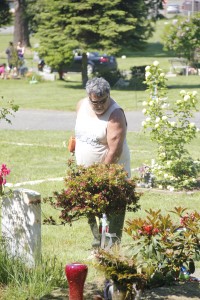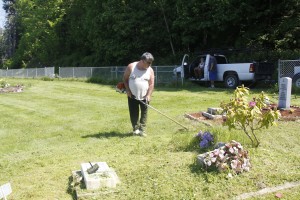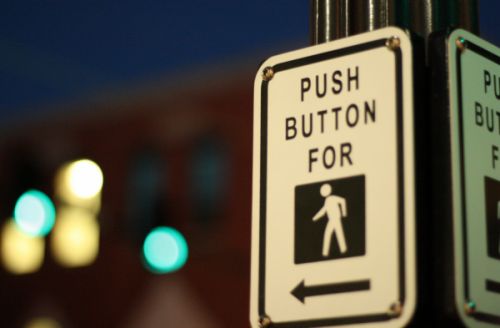Month: May 2014
Memorial Day Preparations
By Andrew Gobin, Tulalip News
Memorial Day will be observed on Monday, May 26 this year. The Tulalip Veterans Department has been working hard to prepare for the ceremonies, cleaning up the cemeteries and placing flags.
Mike Addie, Tony Gobin, and Richard Muir have been working at Priest Point and Mission Beach cemeteries, cleaning up gravesites and doing a bit of landscaping.
“We work on all of the graves, not just the veterans. We want all of the families to be well represented that way,” said Richard Muir.
The three veterans have been working for a few weeks, and will be finished for this weekend’s activities in observance of Memorial Day. Services will be Monday, May 26, 10:00 a.m. at the Priest Point cemetery and 11:00 a.m. at the Mission Beach cemetery.
Andrew Gobin is a reporter with the See-Yaht-Sub, a publication of the Tulalip Tribes Communications Department.
Email: agobin@tulaliptribes-nsn.gov
Phone: (360) 716.4188
What is tribal sovereignty?
By Denise DePaolo, KSFY News
KSFY News – Sioux Falls, SD News, Weather, Sports
South Dakota’s nine Indian reservations exist as sovereign nations. But what does that mean? KSFY News talked with tribal, state and federal leaders about what it means to lead a nation within a nation.
Sovereignty may seem easy to define on paper, but in practice, it’s complicated. To some, it’s a feeling. A way of life.
“Sovereignty, to me, is something our grandfathers gave us. That we need to respect, because it’s a tool that protects us here in Indian Country,” said Rosebud Sioux Tribe President Cyril Scott.
It’s a way of life that involves an ongoing power struggle, colored by a history of eradication.
“The states, the government, they want to take that sovereignty away from us. They don’t want to acknowledge that Adolf Hitler got his ideas from the United States,” said Crow Creek Sioux Tribe Chairman Brandon Sazue.
For tribal governments, sovereignty comes with a limited autonomy.
“When you look at South Dakota, we’re unique in a sense that we have nine different tribes that through treaties and congressional action enjoy a level of tribal sovereignty. That means they have the ability – while they are certainly South Dakotans – that they have the ability to vote in our elections, but they also have a separate sovereignty that allows them to control certain matters within their borders,” said South Dakota Attorney General Marty Jackley.
“We have control of our schools, our courts, our police, so those do make us sovereign, but there’s a lot of things where we are not sovereign. We are still dependent. We are still dependent on the federal government because they have not met their trust responsibility in meeting our needs through economic development,” said Oglala Sioux Tribe President Bryan Brewer.
“They gave us the treaties 200 years ago, 100 years ago, however long ago. Did that give us our sovereignty? In a way, it should have. But today, we don’t have sovereignty,” said Sazue.
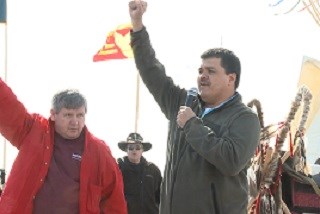 Tribes must follow state and federal laws, which can mean problems when those limits are tested.
Tribes must follow state and federal laws, which can mean problems when those limits are tested.
“For any community in the United States, there are limits. The constitution still needs to be followed and respected. The federal laws still need to be followed and respected,” said South Dakota U.S. Attorney Brendan Johnson.
For example, Pine Ridge is looking into the legalization of marijuana within its borders. Jackley says while he respects tribal sovereignty, pot still is illegal.
“He said he’s going to come to Pine Ridge and arrest us if we did do that,” said Brewer, “And we realize that we have to follow federal law and that. But again, we need to exercise our sovereignty. Pine Ridge has already passed an ordinance years ago legalizing hemp – to grow hemp on our reservation. Yet when a person did, they were arrested.”
Another limit to tribal sovereignty is who can and cannot be prosecuted in tribal courts.
“There are further limitations if there is a non-Indian committing a crime against a non-Indian within the reservation boundaries, the state or the state’s attorney would have jurisdiction over that,” said Jackley.
“I believe we’re going to start arresting everybody. Non-Indians. If they commit a crime on a reservation, we’re going to arrest him, take them through our courts and see what happens. We know it will go to the Supreme Court, but we want to test it, we want to test our sovereignty and we talk about our sovereignty. We’re going to test it through the judicial system,” said Brewer.
“We’re seeing tribal courts strengthened. We’re seeing police departments growing and I think that’s very good, because I think the future of tribal sovereignty means more local control for the tribes, less involvement from federal government,” said Johnson.
According to Brewer, many families living in reservation communities depend on the federal government as well, because job opportunities are few and the cost of utilities like propane and electricity are high.
“We’re all wishing and praying one day that we can be completely sovereign, but as long as we’re within the confines of the United States government, we will probably never be truly sovereign.”
A recent emphasis on economic development and inter-tribal trade aims to change that.
“The future of tribal sovereignty, I think, is about creating alliances. Sovereignty is strongest when you’re using it to create alliances, and I think in South Dakota we’re starting to see that now,” said Johnson.
“We all have something to offer. We can trade with each other. So this is something we’re really looking at,” said Brewer, “We’ve talked to tribes in the northwest. They said ‘Bryan, we’d like to have your buffalo. We have so much diabetes out there. Send us buffalo meat. We’ll send you lumber, we’ll send you salmon.’ The Seminoles out of Florida – ‘We’ll send you oranges. You can use those for your people or you can sell them to communities.’”
South Dakota’s tribes are working on many fronts to become more independent.
Wind energy will help cut down on the high cost of electricity. Several tribes have projects in the works.
The launch of dozens of tribe-operated businesses – like Lakota Popcorn on Lower Brule and Tanka Bars on Pine Ridge – are helping to alleviate the unemployment problem.
Many tribes are also putting an increased emphasis on tourism. For example, the Oglala Sioux will likely become the first tribe to operate a national park in the Badlands’ South Unit.
While tribes are using the increasing connectedness of our world for the betterment of their people, assimilation and eventual obscurity aren’t part of the plan.
“What we are telling the people of the United States and the state of South Dakota – we are a nation. The first nation of this country,” said Scott.
Training begins for Hardin jail; no inmates yet
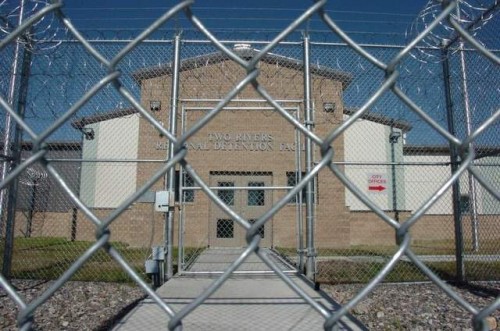
By Matthew Brown, The Associated Press
BILLINGS — A private corrections company from Louisiana is starting to train guards — but still doesn’t have any inmates — for a jail in Hardin that has sat vacant since it was built in 2007, company and town officials said Monday.
Steve Afeman with Emerald Correctional Management said a warden and other personnel have been hired and about 30 guards will be training through the week at the 464-bed Two Rivers Detention Facility.
The company intends to solicit inmates from Native American tribes, counties and the U.S. Marshals Service, Afeman said.
No agreements have been reached, and Chief Deputy Rod Ostermiller with the Marshals Service in Billings said he is not aware of any discussions between his agency and the Lafayette, Louisiana-based company.
The $27 million jail rose to notoriety in recent years after its backers failed to get any contracts for inmates, prompting desperate Hardin officials at one to point to offer to take in suspected terrorists held in Guantanamo Bay, Cuba. A California man later duped officials with a grandiose plan to turn the jail into a military training camp.
The jail is owned by Hardin’s economic development agency, Two Rivers Authority. Emerald signed an operating contract with the authority on May 6 to run the jail, Two Rivers Chairman Jon Matovich said.
Two Rivers would receive 50 cents per day for every inmate under the terms of the deal, Matovich said.
“Everything is signed, the ball’s in (Emerald’s) court and they’re doing a great job,” Matovich said. “Anything that goes on at the facility from now on is Emerald’s stuff. As soon as they get their staff trained and get things rolling, I’m sure they will have some inmates.”
Afeman said representatives of Emerald planned to meet with leaders of tribes from Wyoming, Montana and the Dakotas beginning Wednesday to gauge their interest.
Afeman said in April that the company had reached a memorandum of understanding with the U.S. Bureau of Indian Affairs in which the agency endorsed the company’s plans. But on Monday, Afeman said there was no agreement with the federal agency and that Emerald was working directly with the tribes.
A former employee of the Wyoming Department of Corrections was hired as warden, Afeman said. Kenneth Keller spent three decades with the state agency and in 2008 was appointed warden of the Wyoming Honor Farm, a minimum security facility in Riverton for inmates preparing to re-enter society.
Report: Pedestrian Deaths Disproportionately Affect Native Americans In Wash. State
By Rae Ellen Bichell, KPLU
Pedestrians of American Indian descent at are at higher risk of death in Washington state, according to a report released Tuesday by the National Complete Streets Coalition, a branch of Smart Growth America.
Washington placed 36th out of 50 states and the District of Columbia in a ranking of the most dangerous states to the least dangerous based on the Pedestrian Danger Index, a combined measure of total pedestrian deaths, annual pedestrian deaths and the percentage of people commuting by foot over the past five to eight years. The Seattle-Tacoma-Bellevue area ranked 49th out of 51 large metro areas.
But for Washingtonians of American Indian descent, the statistics aren’t as reassuring. Nationwide, Native Americans have higher rates of fatal traffic accidents than other ethnicities. But that difference is particularly notable in Washington state where all other ethnic groups’ fatality rates are consistently lower than national averages.
‘The Gap, Unfortunately, Is Widening’
The Washington Traffic Safety Commission doesn’t plot pedestrian deaths against ethnicity, although it does publish statistics on factors like age and gender. A report on factors in Washington pedestrian fatalities from 2008 to 2012 acknowledges that “Native Americans are disproportionately killed in pedestrian crashes, representing 8.4 percent of pedestrian deaths but less than 2 percent of the total population.”
“The gap, unfortunately, is widening,” said MJ Haught, a program manager and tribal liaison for the Washington Traffic Safety Commission. Over the course of the past few decades, Haught said, the rate of Native American fatalities went from about 2.4 times that of the general population to 3.3. And in 2013, she said, “the data told us that Native American fatalities are 3.9 times higher than the general population. This is obviously not the way we want to go.”
Unlike Other Groups, Native Americans More At Risk On Rural Roads
Both statewide and nationwide, most pedestrian deaths occur in the more populated urban areas. But according to state data, more Native Americans were killed in crashes on rural roads than on urban ones, opposite the pattern seen with pedestrians of all other ethnicities.
Why? There’s no easy answer, but here are a few factors to consider.
Washington state has 29 federally-recognized American Indian tribes. Alaska, California and Oklahoma are the only other states with more tribes within their borders. According to 2010 U.S. Census data, only six states have American Indian and Alaska Native populations greater than that in Washington.
Each reservation is its own sovereign nation with its own laws, which means roads and signs are built and distributed differently. In rural areas, on tribal lands or off, there aren’t always sidewalks, and not all roads are well-lit.
According to the Center for Disease Control and the National Highway Traffic Safety Administration, Americans of Native American and Alaska Native descent tend to be at higher risk of car injuries overall, not just as pedestrians. Some tribes don’t have seat belt laws.
“If you drill down, a huge factor is unbelted fatalities,” said Haught. “The unbelted fatality rate for native Americans is 7.2 times higher for Native Americans in Washington.”
Alcoholism is often cited as a contributing factor. But intoxication, particularly intoxicated pedestrians, is a contributing factor across the board and is not limited to one ethnicity.
Fatality Rate Likely Underreported
Even with the comparatively high rate of Native American pedestrian deaths reported, we may not be getting the full picture. Because each reservation is a sovereign nation, not every tribe shares data with the state, and the data that is available is conservative.
“The rates for fatalities are coming in with death certificates. We’re pretty good at getting all the reports that happen on Washington land, but not necessarily the reports from reservation land. That varies very much by the tribe and the reservation,” said Haught. “We are confident that the traffic deaths are underreported, so it’s an even worse problem than we realized.”
Thomas Holsworth is commander with the Colville Tribal Police Department in Nespelem, in northwest Washington. The reservation covers 1.4 million acres and, as in many rural areas, most of the roadways that crisscross it are narrow, windy country roads without sidewalks.
“The pedestrian walkways are basically the dirt shoulders of the roadways,” says Holsworth. “But I think a lot of it is, they just tend to walk more, sometimes out of necessity, because … they may not own an operable vehicle. There are others that just like to get out and walk, and there’s not a whole lot of safe places to do that.”
The Confederated Tribes of the Colville Reservation have gone to great lengths to try to reduce traffic-related deaths on tribal lands, assimilating state traffic codes into their tribal code and launching multiple highway safety programs. Funded by a state grant, the tribes ran a public education campaign to increase awareness about using seat belts, driving under the influence, and launched projects to identify problem roads and walking paths.
In the last five years, Holsworth says, there has only been one pedestrian fatality.
Tulalip skateboarders get a say in design plans for new skatepark
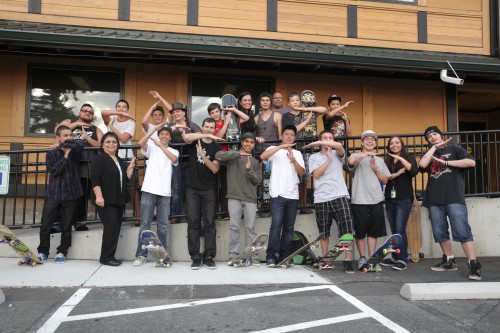
Photo/ Brandi N. Montreuil, Tulalip News
By Brandi N. Montreuil, Tulalip News
TULALIP – Skaters and longboarders had reason to celebrate on May 3, when the Tulalip Board of Directors made a motion to approve funding to build a skate park in Tulalip during a regular board meeting.
Tulalip Skate Park, the unofficial name the park is being called currently, will join a number of skateparks being built on reservations across Indian country, such as recently opened Port Gamble S’Klallam and Lummi Skatepark, opened in April.
A community meeting was held on May 15, at the Tulalip Don Hatch Youth Center, to discuss design ideas, site location, and park size. In attendance were nearly 20 Tulalip youth, including Tulalip Board of Directors, Marlin Fryberg Jr., Deborah Parker, Les Parks, Theresa Sheldon, Marie Zackuse and Tulalip Interim General Manager Misty Napeahi. Micah Shapiro, lead designer for Seattle concrete skatepark design and construction company, Grindline, was also in attendance.
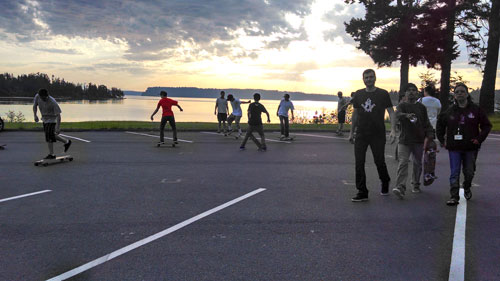
Photo/ Brandi n. Montreuil, Tulalip News
Grindline, who built the Port Gamble S’Klallam Skatepark, creates progressive and engaging skateparks with a design philosophy that each skatepark be tailored to its users and existing surroundings, and welcomes community engagement during the design process.
“I want to support the youth and this Board of Directors wants to support the youth,” said Tulalip vice-chairman Les Parks, to the youth in attendance. “You’ve been asking for a skatepark. There has always been a reason why we can’t make it happen, but this year it is going to happen. September 1 is our deadline that we are going to impose upon ourselves.”
Two sites are being considered for the park’s location, the grassy area in front of the youth center’s council room parking area and across the street from the Greg Williams Court, by the Tribe’s old finance building area. Youth favored the site across the street from the Greg Williams Court due to parking, length of skatepark use, elimination of possible beach erosion, and the incorporation of natural elements into final design ideas.
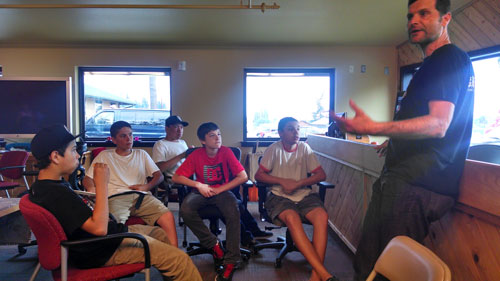
Photo/ Brandi N. Montreuil, Tulalip News
Youth presented conceptual ideas along with concerns about park use, amenities, size and safety. Youth advocated for onsite security to eliminate potential drug use or selling in the area by visitors.
Size of the park was another concern for youth, who toured local parks for ideas. The requested 10,000 to 12,000 square feet would allow for a variety of skating elements in one structure, and cost up to $400,000.
“There are a lot of possibilities that you can do with a skate park,” said Shapiro, during his presentation of finished Grindline skateparks. “What we are doing is getting community input through community outreach. The things that need to be considered when you’re designing a skatepark are flow and who the users will be. You have to look at how elements are related to each other; because you are looking at the environment you are designing in. Places to watch are parking lot access; utilities such as restrooms and lights, adjacent uses and impacts near the park. All that has to be considered.”
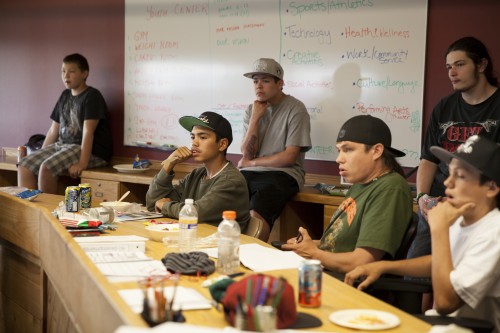
Photo courtesy / Ty Juvinel
“It will come down to budget,” said Tulalip Board Member Marlin Fryberg Jr., about park amenities, such as a request for a roof over the skatepark. “We will have to come up with different options and designs and then go from there. We are not ruling out roof, but that may have to be in phase two of the project.
A final design plan is still being drafted and will include size, location, budget, and skatepark amenities. A budget will be presented once the final design is complete.
For more information on the next community skatepark meeting please contact, Tulalip Youth Services at 360-716-4909.
Brandi N. Montreuil: 360-913-5402; bmontreuil@tulalipnews.com
Tribal groups: Oregon coal terminal will hurt fish
Associated Press
PORTLAND, Ore. — Tribal groups say a coal terminal in the Columbia River Basin would interfere with treaty rights, harm fish and put the health of tribal members at risk.
About 50 Yakama Nation members protested Tuesday at site of the project at the Port of Morrow in Boardman. They say the terminal proposed by Ambre Energy would destroy tribal fishing areas.
The Oregon land board is to decide by May 31 whether to approve the project. In a letter to the board, the company says tribes are currently not fishing at its dock. But treaty rights guarantee a site for tribal use whether it is in use or not.
The company also says its dock would not “unreasonably interfere” with fishing.
Environmental groups and business leaders have also rallied against the project.
Power and water: Will feds allow it for pot?

By C.R. Roberts, The News Tribune
Nobody seems quite sure of the answer: Will the federal government withhold services to the state, given the conflict between legally grown marijuana in Washington and a national drug policy that finds marijuana illegal?
If the answer is no, the U.S. Bureau of Reclamation will allow federal water to be used to irrigate marijuana crops, and the Bonneville Power Administration will allow federal power to be used in the cultivation of marijuana, primarily indoors.
If the answer is yes, then they won’t, in line with federal law.
With something of a wink and a nod, the U.S. Justice Department has provided soft guidance that conditionally allows financial institutions to do business with the marijuana industry. In the same way, utilities and regulatory officials could allow the provision of water and power if Congress could pass legislation the recognizes the will of Washington voters.
Or not.
ENERGY USE
The manufacture of one joint – a marijuana cigarette – will produce 1.5 kilograms of CO2 emissions, equal to the emissions of a 44-mpg hybrid car driving 22 miles. The energy used is equal to that used to produce 18 pints of beer.
U.S. electricity use for cannabis production is the equivalent of 1.7 million average homes, or the production of seven average U.S. power plants.
Of the total wholesale price of U.S.-grown marijuana, 49 percent goes to energy.
“Current indoor cannabis production and distribution practices result in prodigious energy use, costs and unchecked greenhouse-gas pollution,” said Evan Mills of Energy Associates, a California energy consulting firm. The figures are his, offered in a recent study.
“While the implications of I-502 for the criminal justice system, land use, taxation and many other issues have been widely debated, the potentially significant changes in electricity and water use that are likely to follow I-502’s implementation have received almost no scrutiny,” wrote Eric Christensen, of the local firm Gordon Thomas Honeywell, in a blog post last month.
He goes on to say that because marijuana remains illegal under federal law, “legalization creates a new set of legal risks for utility service providers.”
Some utilities say they’re ready for the risks and implications. Maybe.
UTILITIES
More questions: Is Bonneville concerned about the draw on the electrical grid? Has the use of electricity by growers and processors been discussed? Have plans been developed? Will marijuana cultivation and sale have any effect on Northwest power?
“While we are beginning to look at what potential impacts might be, we are not prepared to discuss those issues at this time,” replied BPA spokesman Doug Johnson to an inquiry last week.
Will the utility continue to supply “federal” power to Washington utilities that serve the cannabis industry?
“We are currently exploring these issues. Again, it is too early to discuss the potential policy implications or details of those discussions,” Johnson wrote.
In reality, electricity is already being supplied to the industry.
The greatest effect so far has fallen on Pacific County, home to Raymond, Long Beach and the aptly named Tokeland.
There, an entrepreneur has applied to use 20 megawatts of electricity, which works out to 40 percent of the county’s entire electrical load.
“We have contacted Bonneville (Power Administration), and we are working with Bonneville to build a new substation,” said Jason Dunsmoor, chief of engineering and operations for the Pacific County PUD.
“They will have their own substation,” he said, estimating that the infrastructure cost for the facility and the transmission line will cost some $3 million.
“We’re just providing the service,” he said. “The concern of everybody who invests is that the federal government could change its mind.”
Including the Pacific County facility, by last week the state Liquor Control Board had approved license applications for marijuana processors in 17 counties.
CONSUMPTION AND GENERATION
“We are going to get together and do some inquiries. We haven’t had any specific inquiries. We’ll be taking a look at it and discussing it,” said Karen Miller, communications manager at the Benton County Public Utility District.
“We’re looking at it and trying to make sure we understand all the ramifications and impacts,” she said.
Deb Bone-Harris, Franklin County community and government relations manager, said her utility has “not heard a concern about federal power being an issue. We’d have to deal with that if the time an opportunity were to come up.”
“There has been no formal discussion or agenda item related to this issue at the board level,” said Neil Neroutsos, spokesman for the Snohomish County PUD.
“Puget Sound Energy has a duty and obligation to serve customers under Washington state law,” said Ray Lane, spokesman for Puget Sound Energy, which serves several counties in the state.
“We are confident we have the capacity and resources to provide energy to any new customers who need our service,” he said.
“There have been conversations about the topic,” said Chris Gleason, spokeswoman for Tacoma Public Utilities.
“The interesting thing for us, and for other utilities, the ones who buy power from Bonneville, is whether Bonneville can supply to customers who are supplying to a service that is illegal in most parts of the country,” Gleason continued. “Bonneville is having the discussion about it.”
The answer resides in the other Washington.
Said U.S. Rep. Adam Smith, D-Bellevue, “I understand there are multiple conflicts between state and federal law as it pertains to marijuana. The only way to ensure that state law is recognized at the federal level is by passing the Respect for State Marijuana Laws Act. I am a co-sponsor of this legislation and will continue to advocate for the federal government to recognize and respect our state law.”
Jared Leopold, communications director for Washington Sen. Maria Cantwell, responded late last week, “Senator Cantwell is looking at the potential impacts of implementing Washington’s marijuana law.”
State Rep. Terry Nealey, R-Dayton, has followed the marijuana issue in the state Legislature.
“The unintended consequences continue to rise,” he said last week. “My overall impression, once 502 passed, was ‘Oh my gosh, we’re going to have quite a mess on our hands.’ ”
Nealey said he has asked a Bonneville government liaison specialist about the threat to deny power to the industry.
“She gave me a straight answer,” Nealey said. “We are aware of that problem and the legal department is working with that right now.”
THE GRID
“Part of the question we’re all asking – is this a big deal or not?” said Chuck Murray, senior energy policy specialist at the state Department of Commerce. “That’s because we have no idea how much energy is being used by illegal grows that are hidden from us.”
“My big concern is how much power is going to be required, but it’s very uncertain,” said Chris Robinson, power management manager at Tacoma Public Utilities.
“As a practical matter, we all know there are a lot of illegal grow operations. A lot of them are using Bonneville power already. Many of them are stealing power,” said Eric Christensen, an attorney at Gordon Thomas Honeywell and author of a recent blog post concerning cannabis cultivation and the law.
Some of that theft may go away once a legal network has been established.
Still, he noted the presence of “a number of potentially serious pitfalls for providers of services to marijuana growers, including utilities and irrigation districts.”
Evan Mills of Energy Associates estimated the industry consumes 20 terawatt hours per year nationally, including illegal grow operations.
For off-the-grid operations that consume power from private generators, Mills estimated that one marijuana plant requires 70 gallons of diesel fuel, or 140 gallons of gasoline used with smaller, less efficient generators.
Indoor cultivation in California, Mills wrote, accounts for 3 percent of all electricity use, or the electricity that could power 1 million average homes. Greenhouse gas emissions are equal to those from 1 million average cars.
Sources of energy use include an obvious list with lighting, heaters, humidifiers, de-humidifiers and such, but also include other, less obvious sources, including vehicles, CO2 generators, pumps, filters, fans, security stations and ozone generators.
“Current indoor cannabis production and distribution practices result in prodigious energy use, costs and unchecked greenhouse-gas pollution,” Mills wrote.
In its 2013 report “Environmental Risks and Opportunities in Cannabis Cultivation,” BOTEC, the firm hired by the state to assist in developing rules regarding the implementation of I-502, said “environmental considerations should not be a major component of marijuana policy, but are worth explicit attention and policy design.”
Meanwhile, federal agencies could flummox the whole thing by threatening banks or by denying water or electricity.
“It’s clear that the federal approach to the war on drugs is a complete failure,” said Christensen at Gordon Thomas Honeywell.
“The federal government,” he said, “should at least give us enough space to see if the Washington experiment will work.”
Justice Long Denied Comes to Indian Country; First Post-VAWA Trial Set
The Pascua Yaqui Tribe in Arizona is making history. Nearly 40 years after the U.S. Supreme Court ruled in Oliphant v. Suquamish Indian Tribe (1978) that American Indian tribes did not have jurisdiction over non-Indians who committed crimes on reservations, the Pascua Yaqui are preparing to try as many as 10 non-Indians alleged to have committed domestic violence crimes on their reservation.
The stats for crimes against women in Indian country are appalling. A Department of Justice report states that American Indian/Alaska Native women are significantly more likely to be raped, physically assaulted and stalked than are white women. If, on an Indian reservation, that abuse was committed by a non-Indian, tribal law enforcement was not authorized to arrest the perpetrator and tribal courts did not have the jurisdiction to try him. Both arrest and prosecution were the responsibility of the federal government. But these are such challenging crimes to successfully bring to justice, federal resources are seldom deployed to deal with them.
RELATED: President Barack Obama’s VAWA Law Signing Spotlights Native Women Warriors
The Tribal Law and Order Act of 2010 and the Violence Against Women Reauthorization of 2013 radically changed that. Under VAWA Indian tribes will have jurisdiction over non-Indians who commit domestic violence crimes on reservations. The law will go into effect for all tribes in March 2015, but the Justice Department in February designated three tribes – the Pascua Yaqui Tribe, the Confederated Tribes of the Umatilla Indian Reservation and the Tulalip Tribes of Washington – for a pilot program that allows them to exercise the authority immediately.
RELATED: Three Tribes to Begin Prosecuting Non-Indian Domestic Violence Offenders
Troy Eid, chairman of the Indian Law and Order Commission mandated by TLOA, says, “The Pascua Yaqui Tribe has put a lot of energy into being ready for this day. My impression is they really tried to err on the side of caution so there would be no justification for overturning a tribal court verdict on federal review.”
RELATED: Troy Eid on Why Tribes Need Control Over Their Justice Systems
Listening to Pascua Yaqui Tribe Chief Prosecutor Alfred Urbina describe what has gone into this moment makes “a lot of energy” seem like an understatement. Urbina detailed some of the issues the tribe has had to deal with and what has been learned in an effort to help other tribes put their justice systems in order to begin prosecuting these cases. “The ability to prosecute non-Indians for domestic violence brings up a lot of questions for the tribe,” he says.
Urbina explains that there have been 11 recent incidents on the reservation with American Indian victims and non-Indian suspects; some are still in investigation or waiting for warrants to be served, while some are in the process of being prosecuted. The first trial is scheduled to begin August 19, but some cases could be resolved through plea agreements before that.
One thing that has been surprising is the number of cases. “We thought we’d have 5 to 10 cases for the whole calendar year,” Urbina says. “But in just the first two months since the tribe has had the authority to arrest non-Indians, there have been more than 10 arrests.”
Demographics are critical to predicting how many cases tribes will need to prepare for. So is location – whether or not the reservation is near an urban center or a major highway. Among the questions tribes will have to address is: Who is actually living in tribal housing? The perception is that tribal members live in tribal housing, but there are probably other people as well, especially if there are a lot of single mothers, says Urbina.
Other questions shed light on matters such as – What is the composition of law enforcement on the reservation? Do people trust law enforcement? Urbina explains that if people have seen non-prosecution of DV cases for many years by both tribal and federal authorities, distrust may have built up and this will affect the success of the cases the tribe brings to trial. How does the tribe get a warrant served off-reservation and the suspect extradited back to the reservation for trial? What if a suspect does not speak English—will an interpreter be available for court proceedings and for conferring with an attorney?
Then there is the question of public defenders. “Some tribes are saying we just need to hire a lawyer, but that person would need to have a background in Indian law, Indian sovereignty issues, different ways of doing things in Indian country and tribal court history. If the lawyer doesn’t have that kind of information it will impact the case.”
One compromise that had to be made to get the law passed was that the attorneys and judges in cases where whites are being tried have to be state-licensed. This brings up the question of access. How will public defenders hired by the tribe have access to their clients on rural reservations?
And that in turn brings up the question of costs—of public defenders, judges, travel, housing of both legal personnel and of those being held for trial and medical care for prisoners. These are issues that if not handled correctly could lead to federal appeals on constitutional grounds, Urbina explains.
Urbina estimates it could cost up to $500,000 for a tribe to get their justice system set up to meet the prerequisites to prosecute non-Indians for domestic violence crimes. “The process will be out of reach for some tribal governments without significant assistance from the federal government, but in order to get this law passed, no money was appropriated for that purpose,” says Urbina.
Nonetheless, the Pascua Yaqui are in a financial position to bring justice long delayed to women on their reservation and they are wasting no time in getting started. Says Eid, “Nothing could be more important for a tribal government to do. This has been an area where law and order breaks down. It’s important that this works.” Urbina puts it this way: “There is nothing more basic than the right to live in peace. Everything else flows from that.”
Read more at http://indiancountrytodaymedianetwork.com/2014/05/20/justice-long-denied-comes-indian-country-first-post-vawa-trial-set-154945?page=0%2C2
Reservations targeted in consolidation program
By The Associated Press
These are the American Indian reservations the Department of Interior plans to focus on in the next phase of a $1.9 billion buyback program of fractionated land parcels to turn over to tribal governments. The program is part of a $3.4 billion settlement over mismanaged money held in trust by the U.S. government for individual Indian landowners.
— Assiniboine and Sioux Tribes of the Fort Peck Indian Reservation, Montana.
— Cheyenne River Sioux Tribe of the Cheyenne River Reservation, South Dakota.
— Coeur D’Alene Tribe of the Coeur D’Alene Reservation, Idaho.
— Confederated Salish and Kootenai Tribes of the Flathead Reservation, Montana.
— Confederated Tribes of the Umatilla Reservation, Oregon.
— Crow Tribe, Montana.
— Fort Belknap Indian Community of the Fort Belknap Reservation of Montana.
— Gila River Indian Community of the Gila River Indian Reservation, Arizona.
— Lummi Tribe of the Lummi Reservation, Washington.
— Makah Indian Tribe of the Makah Indian Reservation, Washington.
— Navajo Nation, Arizona.
— Northern Cheyenne Tribe of the Northern Cheyenne Indian Reservation, Montana.
— Oglala Sioux Tribe of the Pine Ridge Reservation, South Dakota.
— Prairie Band Potawatomi Nation, Kansas.
— Quapaw Tribe of Indians, Oklahoma.
— Quinault Tribe of the Quinault Reservation, Washington.
— Rosebud Sioux Tribe of the Rosebud Indian Reservation, South Dakota.
— Sisseton-Wahpeton Oyate of the Lake Traverse Reservation, North Dakota and South Dakota.
— Squaxin Island Tribe of the Squaxin Island Reservation, Washington.
— Standing Rock Sioux Tribe of North Dakota and South Dakota.
— Swinomish Indians of the Swinomish Reservation, Washington.
___
Source: U.S. Department of the Interior.


